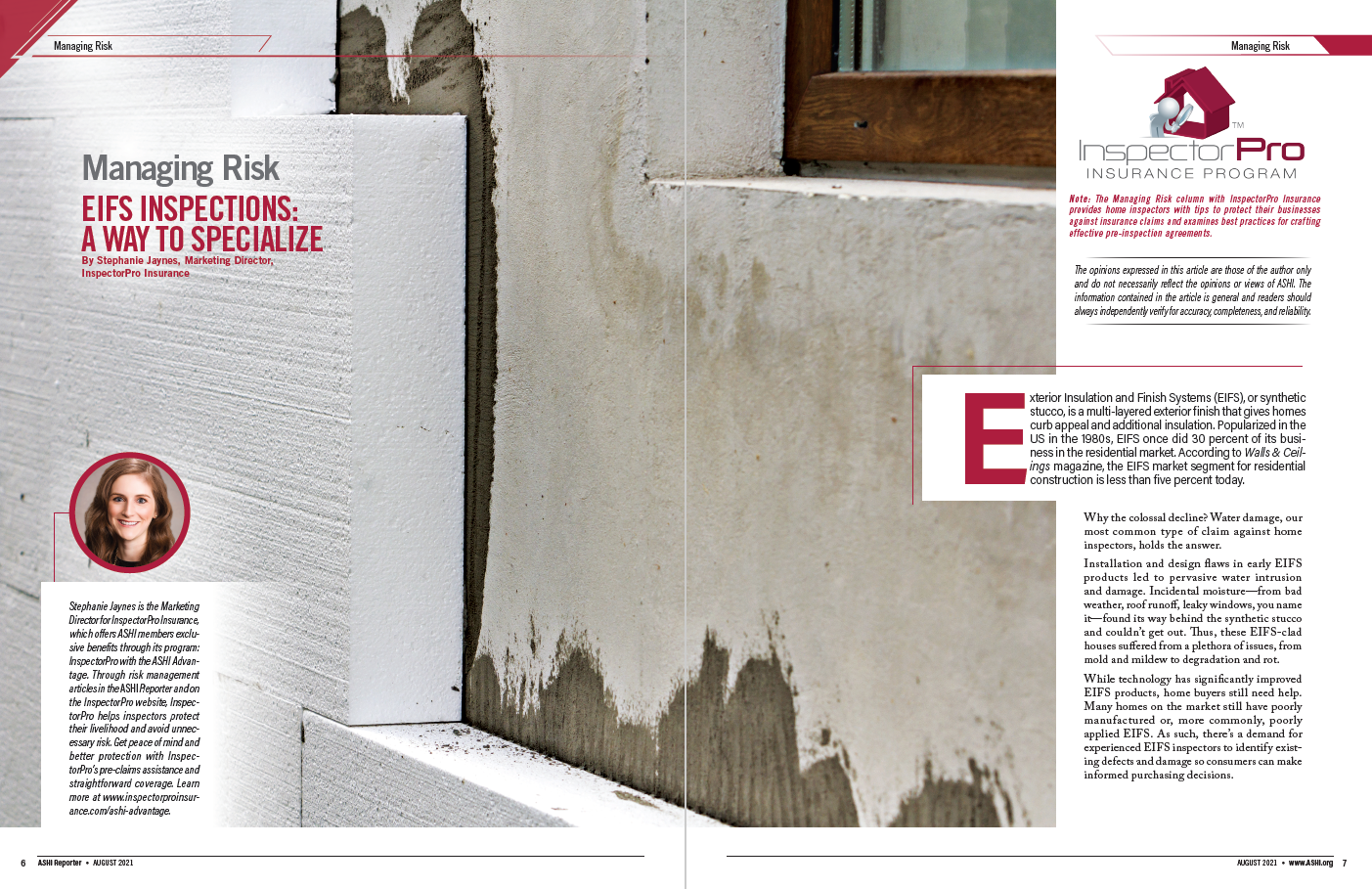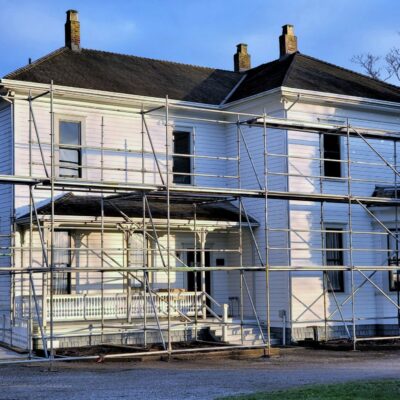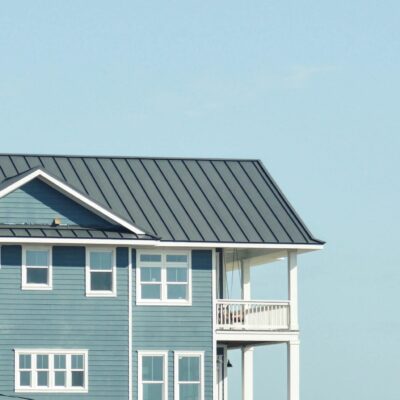EIFS Inspections: A Way to Specialize
Last Updated November 27, 2023

Exterior Insulation and Finish Systems (EIFS), or synthetic stucco, is a multi-layered exterior finish that gives homes curb appeal and additional insulation. Popularized in the United States in the 1980s, EIFS once did 30 percent of its business in the residential market. According to Walls & Ceilings Magazine, the EIFS market segment for residential construction is less than five percent today.
Why the colossal decline? Water damage, our most common type of claim against home inspectors, holds the answer.
Installation and design flaws in early EIFS products led to pervasive water intrusion and damage. Incidental moisture—from bad weather, roof runoff, leaky windows, you name it—found its way behind the synthetic stucco and couldn’t get out. Thus, these EIFS-clad houses suffered from a plethora of issues, from mold and mildew to degradation and rot.
While technology has significantly improved EIFS products, home buyers still need help. Many homes on the market still have poorly manufactured or, more commonly, poorly applied EIFS. As such, there’s a demand for experienced EIFS inspectors to identify existing defects and damage so consumers can make informed purchasing decisions.
Why home inspectors offer EIFS inspections.
The home inspectors we interviewed perform EIFS inspections for the following reasons.
1. They want to meet demand.
Some of the home inspectors we surveyed indicated that they started offering EIFS inspections in response to requests from real estate agents. Depending on the prevalence of homes built in the 80s and the concern regarding water damage in your area, you may see a higher demand for EIFS inspectors.
2. They wanted to differentiate their businesses.
Other home inspectors we surveyed, like Mike Leggett of The BrickKicker of Georgia, began offering EIFS inspections to expand on their offers to clients.
“We introduced most of our ancillary services—[including EIFS]—to differentiate ourselves from other inspectors in our market,” Leggett said.
For Scott Patterson of Trace Inspections, it was particularly important to offer an additional service that his competitors weren’t offering. In so doing, he hoped to capture clients looking for a one-stop shop.
“In my area of middle Tennessee, we only have four inspectors that are doing this type of specialized inspection,” Patterson said.
Investments inspectors make
Education & Licensing
Inspectors and claims specialists alike recommend that home inspectors take a class that focuses on EIFS. Even if your state doesn’t require coursework or certifications, the knowledge you obtain by taking a class about EIFS can differentiate your business, better your inspection and reporting skills, and manage your risk.
Third-party training schools, like the Exterior Design Institute (EDI)—which David Nason of Best Inspections, LLC in Wisconsin recommends—offer EIFS courses, too. Choose the best one for you based on your state requirements, interests, and budget.
Most states do not require EIFS inspectors to have a license. But some—like Alabama—do. Be sure to check your state laws to see if your area requires licensure and what you need to do to obtain licensure.
Equipment
All EIFS inspections should begin with a visual examination. Most of the home inspectors we surveyed supplemented what they could see with the naked eye with tools like wall scanners and infrared (IR) cameras. (For more on thermal imaging, read our article “Infrared Cameras: Redefining the visual, non-invasive home inspection.”)
In most cases, you won’t be able to find evidence of water intrusion with a visual inspection of EIFS alone. Thus, investing in a high quality, pin-type moisture meter is essential. But be sure that such moisture intrusion tests with an invasive moisture meter are covered by your home inspector insurance policy.
In places where you identify high moisture content or a soft section of wall, you’ll need equipment to remove sections of the EIFS to inspect the substrate or framing more closely. However, in most cases, home inspector insurance policies will only cover drilling a hole to insert a moisture meter; they do not cover wall removal. Read your policy or talk to your insurance broker to learn what’s covered. You can also learn what your options for additional coverage are, if any.
When purchasing EIFS inspection equipment, inspectors may buy such equipment individually or in pre-packaged kits for around $3,000.
Endorsements
An endorsement is a form that either modifies or adds coverage to your insurance policy. Most home inspection insurance policies exclude additional services like EIFS inspections. Thus, the insurance company will not offer coverage for those additional services without an endorsement. So, if you perform EIFS inspections or want defense and indemnity for claims involving pools and spas, you may wish to change an existing policy exclusion with an endorsement.
Typically, insurers charge a flat, annual fee around $200 for an intrusive EIFS endorsement. Due to the knowledge required to properly perform EIFS inspections, some home inspection insurance providers require you to hold an EIFS certification from a training school or learning platform before they’ll provide you with the endorsement. Talk to your insurance broker to find out what requirements they have, if any.
Limiting your liability against EIFS-related claims
Carrying an EIFS endorsement is one of the most important things you can do to protect against related claims. However, there are additional risk management techniques you can employ to safeguard your business. Below are some suggestions.
Set expectations.
Make sure your clients understand the limitations of your inspection and how they apply to EIFS.
According to the ASHI Standard of Practice (SOP), home inspections are visual, non-invasive examinations of the home’s physical structures and systems. Because the ASHI SOP only covers what you can see and not anything hidden from view—like moisture behind walls—it’s vital that you describe just how your EIFS inspection will exceed that standard. Explain your inspection methods and what you can (and can’t) reasonably discern from those methods.
You can also help your clients have realistic expectations by referring them to national, state, and local standards. In many cases, such standards can act as one of your lines of defense.
For more information on setting expectations, read our article “How to Set Home Buyers’ Expectations” on our website.
Know your stuff.
To proficiently report synthetic stucco-related defects, you must be familiar with those defects. Randy Sipe of Family Home Inspection Services in Kansas believes that a lack of knowledge of current changes to building standards contributes to poor reports.
“If you don’t know what you’re looking at, you’re going to have a hard time writing about it,” Sipe said.
According to Miki Mertz of Complete Home Inspection in Kansas, a good understanding of property systems and components—including EIFS—will make you more equipped to provide your clients with thorough inspections. While it’s sometimes necessary to refer clients to specialists (more on that later), Mertz argues that some home inspectors will make unnecessary referrals due to a lack of knowledge or expertise.
“There’s a difference between saying, ‘This is broken. I recommend an expert fix it,’ and ‘I don’t know what I’m looking at. Go have somebody else look at it,’” Mertz said.
Have a procedure.
You are less likely to make mistakes if you use the same procedure for each inspection. Develop a procedure that dictates how you perform EIFS inspections, including what you look for and when. By never deviating from your inspection procedure, you’ll be less likely to miss a step from one client to the next.
“I manage my risk by being well-trained and performing my inspections consistently—following a protocol that minimizes the chance for me to miss something,” Nason said.
Try to create a procedure that is straightforward, easy to remember, and doesn’t have to vary from house to house. If it helps in the beginning, try creating a physical checklist to run through during each EIFS inspection.
When in doubt, contract it out.
While it’s not good customer service to default to referrals (see Mertz’s quote from earlier), it is important to make a referral when you’re unsure of something.
When it comes to specialty inspections, there are some things you cannot or should not diagnose. Perhaps an issue goes beyond your inspection’s scope. Or maybe something you see is beyond your expertise. In such cases, don’t be afraid to recommend a specialist for further evaluation.
EIFS and your home inspections
Are real estate agents asking for EIFS inspections? Looking for a way to differentiate your business?
If you answered “yes” to either of these questions, perhaps it’s time for your company to offer EIFS inspections.
This article was published in the ASHI Reporter in August 2021. See how this story appears in print below.






